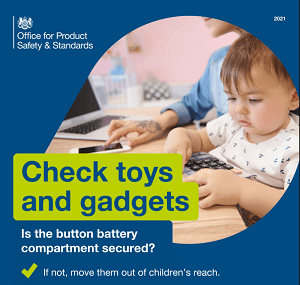Why are Button Batteries So Dangerous?
The message about keeping small children and toddlers safe from button battery ingestion is an important one for all parents and guardians.
Everyday items powered by coin cell batteries include things like:
- Children’s toys
- Hearing aids
- TV remote controls
These flat, round, single cell batteries have become commonplace in our homes. But, they could injure a child (or kill them) if swallowed.
Button batteries create caustic soda when they react with saliva. In fact, this is the same chemical that we use to unblock the drains in kitchens and bathrooms.
The real danger occurs when a child finds a button battery and puts it in their mouth. If swallowed, the small cell can get stuck in their oesophagus (food pipe).
Caustic soda can cause a reaction that burns a hole in the throat. This may then lead to internal bleeding, and in some cases – death! It may also cause severe tissue damage if the chemical makes its way to the stomach.
In case you were wondering:
Medical experts say lithium ‘coin cells’ are the most dangerous for children (if ingested). They measure about the same size as the five pence coin (18.0mm in diameter).
Even so, smaller batteries also create hazardous situations for infants and small children. A child might insert the tiny cell into one of their body orifices (e.g. ears, nose).
Besides the OPSS, you can also get more information about managing the risks that button batteries create from several other organisations, including:
- British and Irish Portable Battery Association
- Child Accident Prevention Trust
- Royal Society for the Prevention of Accidents (RoSPA)
Note: You can download consumer safety awareness campaigns materials to post the button battery child safety campaign on social media (e.g. using the hashtag #buttonbatteries).
Storing Button Batteries Securely
Parents and guardians should store spare batteries in a safe and secure place (in a locked drawer). Leaving them in a loose drawer, or on a kitchen worktop, will not be out of reach for ‘inquisitive’ children’.
It is also important to be aware of which everyday products contain button batteries, and make sure the battery compartment is secure (e.g. by a screw).
Popular gadgets and children’s toys that use coin cell batteries include:
 Car key fobs
Car key fobs- Fish toys or robot bug
- Fidget spinners with LED lights
- Gaming headsets
- Musical greeting cards
- Nightlights
- Novelty items (e.g. singing Santas)
- Personal calculators
- Slim size remote controls
- Watches
- Weighing scales
Important: Take extra care to avoid dropping them on the floor when opening button battery multi-packs.
Teaching Children about Button Battery Safety
One of the roles of good parenting is communicating with older children about the various dangers and hazards in the home (e.g. basic fire safety for kids).
Hence, it is important to include why older children should not play with batteries or allow younger children to have access to them.
Don’t Delay Getting Rid of Button Batteries
Dead batteries often end up in places where they shouldn’t (e.g. lying around underneath sofa cushions). Even so, they may still contain enough power to injure a small child.
So, always store button batteries in a secure location, and then recycle them in the proper manner and without any undue delay.
Note: Another section explains much more about the waste battery collection rules for retailers in the United Kingdom.
What if a Child Swallows a Button Battery?
It’s important to act promptly if you suspect your child has swallowed a coin cell battery. You should call 999 for an ambulance or take them to the nearest Accident and Emergency department without delay.
Try to take the actual battery packaging, the gadget, or the toy with you. Doing so can help hospital staff identify what kind of battery the child ingested.
Even though the symptoms of battery ingestion may not be obvious, be vigilant because the child is likely to be:
- Coughing
- Drooling saliva
- Gagging
- Pointing to their throat (or belly)
Do…
- Trust your instincts and act fast (try not to panic).
- Help the medical staff identify what the child swallowed.
Do Not…
- Let the child eat food or drink fluids.
- Do anything that would make the child vomit (be sick).
Magnet Safety Campaign Launched
The potential dangers to children from ingesting small high-powered magnets should not be underestimated. The OPSS released a few basics steps that parents and carers can take to make a safer environment for small kids to play.
Small children can suffer serious internal injuries if they swallow tiny magnets. In fact, these tiny pieces of iron may even cause life-threatening damage to a child’s digestive system if swallowed.
Signs and Symptoms of Magnet Ingestion
Following these basic safety tips can reduce the likelihood of your child swallowing small magnets and suffering serious internal injuries:
- Check to see if your child has been playing with any toys that contain small magnets if they have a fever, stomach pain, or they start vomiting.
- Educate older children about the dangers associated with kids who put tiny magnets near or inside their mouths.
- The #MagnetSafety campaign recommends keeping products that contain small or loose magnets out of reach for young children.
Important: Take your child to the nearest A&E department without delay (or telephone 999) if you suspect your child has swallowed a magnet.
Related Help Guides for Parents
- Food imitation law in the United Kingdom.
- How to report faulty toys to your local Trading Standards.
- Free grooming software to improve child safety online.
Note: The short video, presented by the BBC, explains more about how button batteries pose a ‘deadly’ risk to toddlers and small children (viewer discretion advised).

